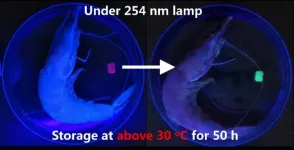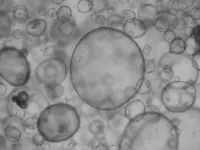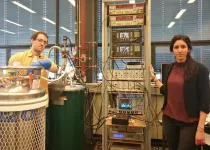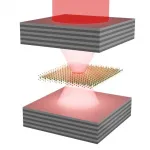Engineers and biologists join forces to reveal how seals evolved to swim
New research combines cutting-edge engineering with animal behaviour to explain the origins of efficient swimming in Nature's underwater acrobats: Seals and Sea Lions
2021-05-06
(Press-News.org) New research combines cutting-edge engineering with animal behaviour to explain the origins of efficient swimming in Nature's underwater acrobats: Seals and Sea Lions.
Seals and sea lions are fast swimming ocean predators that use their flippers to literally fly through the water. But not all seals are the same: some swim with their front flippers while others propel themselves with their back feet.
In Australia, we have fur seals and sea lions that have wing-like front flippers specialised for swimming, while in the Northern Hemisphere, grey and harbor seals have stubby, clawed paws and swim with their feet. But the reasons why these two different ways of swimming evolved has perplexed biologists for generations. Is one style better than the other?
But now a Monash University-led interdisciplinary study published in Current Biology has used cutting-edge computer simulations alongside footage of live seals to finally answer this evolutionary mystery.
"The difference in swimming style between forelimb and hindlimb propelled seals is so great that these groups were originally thought to have evolved from separate land-dwelling ancestors," said lead study author Dr David Hocking from the Monash University School of Biological Sciences, "but the genetics clearly shows that all living seals come from the same group of animals."
The question is, how could such different swimming styles evolve within the one animal group?
To reveal the answer, Dr Hocking teamed up with Monash University engineer Dr Shibo Wang from the Department of Mechanical and Aerospace Engineering, and used advanced Fluid Dynamics simulations to show how water flows around seal flippers of different shapes.
"Our analysis showed that some Antarctic seals, like leopard seals, actually have very streamlined, wing-like forelimbs, despite being from the 'foot-propelled' seal family," said Dr Wang. This is supported by footage of live leopard seals swimming at Taronga Zoo, where they used their front limbs to swim in a similar way to the fur seals and sea lions.
This discovery shows how wing-like flippers can evolve in seals that already swim with their back feet, providing a pathway for the evolution of forelimb swimming in the fur seals and sea lions.
"Wing-like flippers help leopard seals to surge forward and ambush fast-swimming penguins," said Associate Professor Alistair Evans who also collaborated on the study, "and it seems likely that the earliest sea lions also needed this extra speed to capture their preferred prey: schooling fish".
"We finally have a window into the early evolution of swimming in seals," Dr Evans said.
But as well as explaining the origin of seals, this study also has a more practical outcome: improved human designs. "Seals have had millions of years to perfect their swimming, and they can teach us a thing or two about underwater grace and elegance," said Dr Hocking. "Learning from them may help us to improve the design of human-built machines like underwater drones and submersibles, increasing their speed, manoeuvrability or energy efficiency."
Who knows? Perhaps in future we will be able to know how it feels to swim like a seal thanks to seal-shaped submarines.
INFORMATION:
ELSE PRESS RELEASES FROM THIS DATE:
2021-05-06
Sea turtles are known for relying on magnetic signatures to find their way across thousands of miles to the very beaches where they hatched. Now, researchers reporting in the journal Current Biology on May 6 have some of the first solid evidence that sharks also rely on magnetic fields for their long-distance forays across the sea.
"It had been unresolved how sharks managed to successfully navigate during migration to targeted locations," said Save Our Seas Foundation project leader Bryan Keller, also of Florida State University Coastal and Marine Laboratory. "This research supports the theory that they use the earth's magnetic field to help them find their way; it's nature's GPS."
Researchers ...
2021-05-06
Scientists in China and Germany have designed an artificial color-changing material that mimics chameleon skin, with luminogens (molecules that make crystals glow) organized into different core and shell hydrogel layers instead of one uniform matrix. The findings, published May 6 in the journal Cell Reports Physical Science, demonstrate that a two-luminogen hydrogel chemosensor developed with this design can detect seafood freshness by changing color in response to amine vapors released by microbes as fish spoils. The material may also be used to advance the development of stretchable electronics, dynamic camouflaging robots, and anticounterfeiting technologies.
"This novel core-shell layout does not require a careful choice of luminogen pairs, nor does it require an ...
2021-05-06
Mini-organs or organoids play a big role in the future of medicine. Their countless applications can help develop and implement tailored therapies for each patient. The revolutionary development of organoids started in Utrecht with a group of curious scientists. But when organoid research starting booming, confusion arose. What exactly is an organoid? Are there different types, and if so, what should they be called? A group of experts from around the world now publishes the first consensus on what is - and what is not - an organoid.
Bart Spee, Associate Professor at Utrecht University's faculty of Veterinary Medicine, is ...
2021-05-06
The "Third Pole" of the Earth, the high mountain ranges of Asia, bears the largest number of glaciers outside the polar regions. A Sino-Swiss research team has revealed the dramatic increase in flood risk that could occur across Earth's icy Third Pole in response to ongoing climate change. Focusing on the threat from new lakes forming in front of rapidly retreating glaciers, a team, led by researchers from the University of Geneva (UNIGE), Switzerland, demonstrated that the related flood risk to communities and their infrastructure could almost triple. ...
2021-05-06
New research by Joseph Wu, Edgar Engelman, and colleagues at Stanford University, US has advanced an old concept to develop a new strategy to train the immune system of mice to recognize cancer cells. This work is based on the recent understanding that induced pluripotent stem cells (iPSCs), which are stem cells generated from skin or blood cells through a method called reprogramming, produce a large set of antigens that have overlap to a specific type of pancreatic cancer and that these similarities can be used for potential clinical benefit.
It is well known that vaccines can be highly effective ...
2021-05-06
In spintronics, the magnetic moment of electrons (spin) is used to transfer and manipulate information. An ultra-compact 2D spin-logic circuitry could be built from 2D materials that can transport the spin information over long distances and also provide strong spin-polarization of charge current. Experiments by physicists at the University of Groningen (The Netherlands) and Colombia University (USA) suggest that magnetic graphene can be the ultimate choice for these 2D spin-logic devices as it efficiently converts charge to spin current and can transfer this strong spin-polarization ...
2021-05-06
At extremely low temperatures, matter often behaves differently than in normal conditions. At temperatures only a few degrees above absolute zero (-273 degrees Celsius), physical particles may give up their independence and merge for a short time into a single object in which all the particles share the same properties. Such structures are known as Bose-Einstein Condensates, and they represent a special aggregate state of matter.
An international team of researchers led by physicists Dr Carlos Anton-Solanas and Professor Christian Schneider from the UNiversity of Oldenburg has now succeeded for the first time in generating this unusual quantum state in charge carrier complexes that are closely linked ...
2021-05-06
Hydrogen-based fuels should primarily be used in sectors such as aviation or industrial processes that cannot be electrified, finds a team of researchers. Producing these fuels is too inefficient, costly and their availability too uncertain, to broadly replace fossil fuels for instance in cars or heating houses. For most sectors, directly using electricity for instance in battery electric cars or heat pumps makes more economic sense. Universally relying on hydrogen-based fuels instead and keeping combustion technologies threatens to lock in a further fossil fuel dependency ...
2021-05-06
ROCHESTER, Minn. ? Heart disease can take a number of forms, but some types of heart disease, such as asymptomatic low ejection fraction, can be hard to recognize, especially in the early stages when treatment would be most effective. The ECG AI-Guided Screening for Low Ejection Fraction, or EAGLE, trial set out to determine whether an artificial intelligence (AI) screening tool developed to detect low ejection fraction using data from an EKG could improve the diagnosis of this condition in routine practice. Study findings are published in Nature Medicine.
Systolic low ejection fraction is defined as the heart's inability to contract strongly enough with each beat to pump at least 50% of the blood from ...
2021-05-06
What The Editorial Says: JAMA Health Forum debuts this week as a peer-reviewed, open-access, online journal focused on health policy, health care systems, and global and public health. The journal has transitioned from an online health policy channel and is the newest member of the family of JAMA Network specialty journals. The editor of JAMA Health Forum is John Z. Ayanian, M.D., M.P.P., of the University of Michigan in Ann Arbor, and the deputy editor is Melinda B. Buntin, Ph.D., of the Vanderbilt University School of Medicine in Nashville, Tennessee.
Authors: John Z. Ayanian, M.D., M.P.P., of the University of Michigan in Ann Arbor, is the corresponding author.
To access the embargoed study: Visit our For The Media website at ...
LAST 30 PRESS RELEASES:
[Press-News.org] Engineers and biologists join forces to reveal how seals evolved to swim
New research combines cutting-edge engineering with animal behaviour to explain the origins of efficient swimming in Nature's underwater acrobats: Seals and Sea Lions




